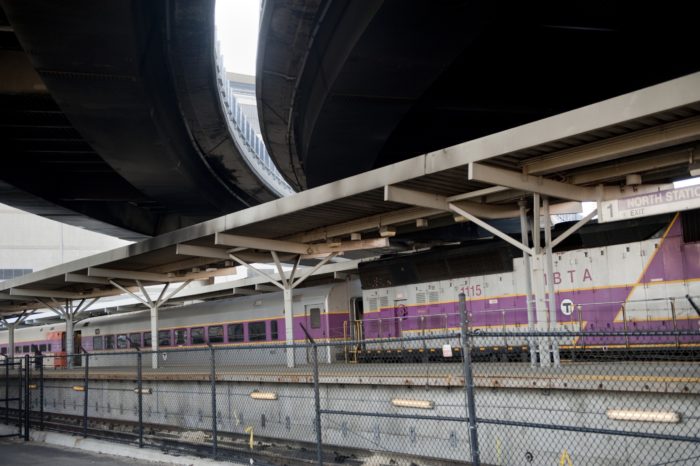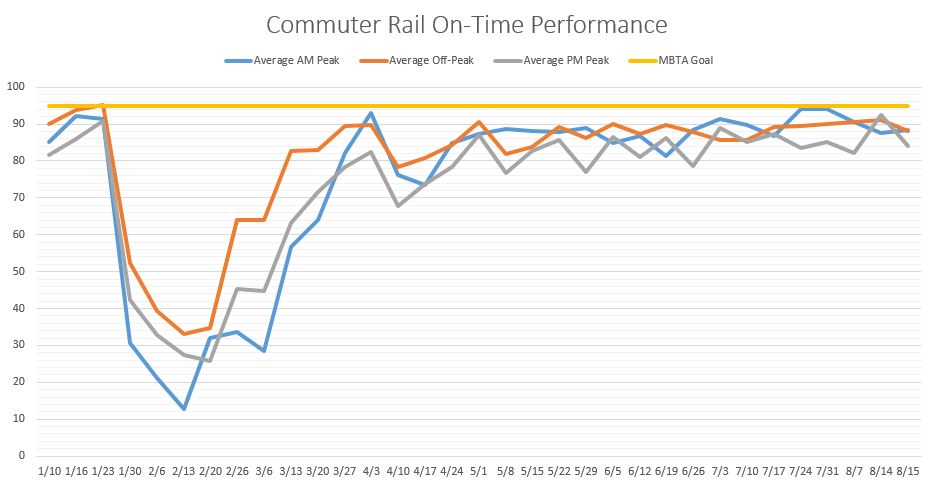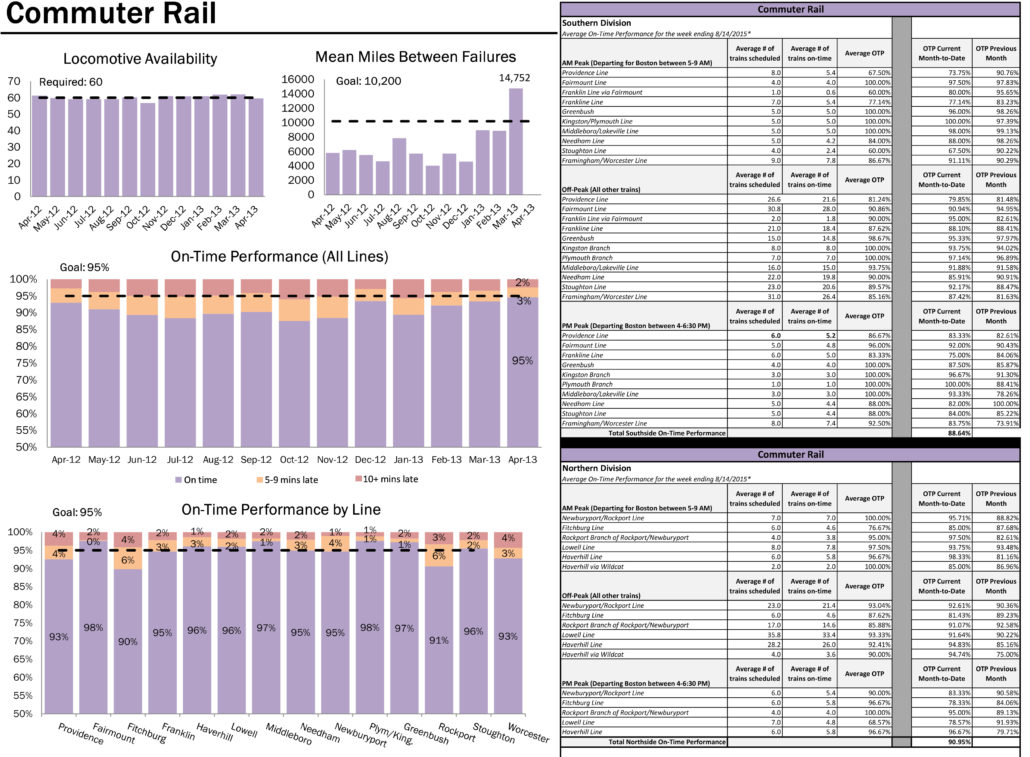Getting Tough on Keolis?
You rush to feed your kids breakfast; leave your house so fast you forget your lunch; arrive breathless at the train station, right on time and sweating through your clothes. Each minute matters when you’re a commuter rail rider.
Bet when you get there there’s no train in sight and no alert from the T. Sound familiar?
Even with the never-ending blizzard of 2015 finally in the rear-view mirror, commuter rail riders are still experiencing what have become standard yet inexcusable delays. Two weeks ago, evening commute performance scored just 82 percent. It was 85 percent the week before and only 83 the week before that.
Pioneer Institute has been a consistent watchdog of Keolis’ performance since they took the reins of the commuter rail system just over a year ago. Even in the beginning, Keolis’ struggled to maintain respectable on-time performance, consistently clocking in below historical norms.
For years the on-time performance target has been 95 percent, and for years the Massachusetts Bay Commuter Railroad Company (MBCR) managed to come close. From July, 2012 through October, 2014 (the range for which MassDOT’s Office of Performance Management and Innovation has posted data), MBCR’s average on-time performance was 90 percent. In the first ten months of 2013, the average rate was 92 percent, and it actually reached 95 in April of 2013.
On the other hand, since May (when Keolis’ performance and schedule finally recovered from the winter) morning trains have averaged 89 percent on-time performance, off-peak trains averaged 88 percent, and evening commute trains just 84 percent. (Because on-time performance reports are now released with three different measures of performance based on time of day, it is difficult to calculate an overall performance level) It is quite clear that Keolis is having serious, systemic issues.
If you need to get home to cook dinner, give meds to your aging parents, drive your kids to practice, or any combination of the above, a few minutes make a big difference. If you need to get to that interview, exercise before work, or beat your boss to the office, minutes matter.
If Keolis did their due diligence before bidding on a $2.7B eight-year contract, they would have understood the threat of an aging fleet and infrastructure. The “no-excuses” contract was very clear about penalties for failing to meet performance goals; each month Keolis can be fined up to the level of its assumed profit, $868,850, for late trains and cleanliness/staffing shortcomings. Altering the expectations of the contract, especially penalties for sub-par performance, is unfair to companies like MBCR and Veolia who formulated bids with these penalties in mind.
The MBTA was lenient on Keolis during the winter, exempting the company from some fines during the worst of the snow. Still, in its first eight months at the helm, Keolis racked up over $4 million in penalties. Last month the MBTA reverted those penalties, $7.5 million, back to Keolis to help them live up to the terms of their contract. Additionally, the MBTA lowered the on-time performance target from its historical level of 95 percent to 92.
The on-time performance target is typically high because it is the most important metric for a commuter rail system. When trains run once an hour, it is critical that riders have confidence that trains will arrive when they’re supposed to. The only major commuter rail system in the country which has a lower on-time performance target is SEPTA in Philadelphia, whose target is 91 percent.
Keolis’ inability to meet the old standard is not evidence that it can’t be met. Targets aren’t designed to be consistently reached anyway; their purpose is to define a minimum performance level which is acceptable. Setting a lower goal does not guarantee performance improvements or a change in Keolis’ attitude, it only lowers the expectation.
The new fine system considers each day separately instead of each month, and institutes a 90 percent goal for each line. If monthly fine limits persist, it is unclear how this will increase pressure to improve service. If the maximum fine is reached early, Keolis would still have no incentive to improve service for the remainder of the month.
The MBTA’s commuter rail is also the only major system in the country which has been losing ridership. Data from the National Transit Database shows that between 2003 and 2013, annual passenger trips increased by 63 percent on average for other top ten commuter rail systems, while declining by 13 percent at the MBTA. This is in spite of a 2007 expansion adding the Greenbush line, and expansions to Rhode Island in 2010 and 2012.
This is not the time for the MBTA to be scaring away more passengers with unreliable service. Minutes do matter and if commuters aren’t able to rely on the schedule they may forgo commuter rail altogether.
There is an immediate, albeit intermediate, step that Keolis can take to increase its customers’ confidence: increase transparency. Following the announcement of the scaled-back on-time performance target, Transportation Secretary Stephanie Pollack disclosed that many late trains are only a few minutes behind schedule. If this is true, then prove it using the on-time performance reports that are released weekly by MassDOT.
As Pioneer has previously noted, the old on-time performance reports divulged much more information than the current manifestation, including overall on-time performance, the number of trains which are more or less than five minutes late, and even the on-time performance of the MBTA’s subway system. Compare the two commuter rail reports below to see the blatant decline in the quality of data being released to the public. (Old reports can be accessed on this page which is accessible only though a Google search or direct link)
(The report on the left is from May, 2013 and demonstrates the previous report style; the report on the right is from August, 2015 and shows the new format)
Keolis is contractually obligated to “produce daily, monthly, and annual reports including On Time Performance and the number of Customer Delays, Late Trains, Cancelled Trains, and Terminated Trains.” This is information that could assuage the public’s doubt about Keolis’ ability to meet adequate standards. Instead, we get bare-bones weekly reports.
Diminished public confidence is a guaranteed side effect of years of deferred maintenance, nontransparent operations, and dismal performance during a difficult winter. Lowering the acceptable standard for performance is a step in the wrong direction for the MBTA.
Instead Keolis needs to be clear about its performance and let riders make an informed choice.






